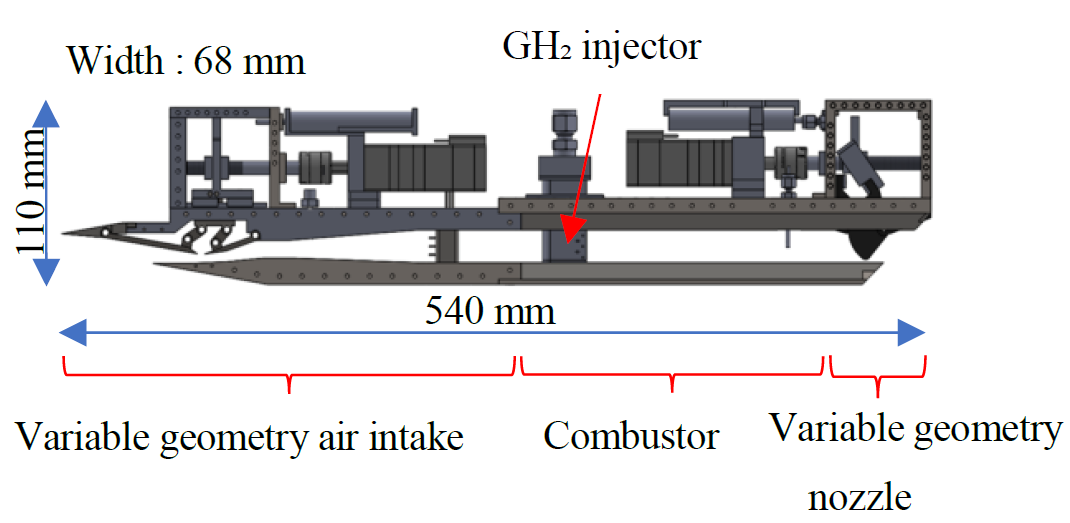Numerical Simulation of the Ram Combustor
JAXA Supercomputer System Annual Report February 2021-January 2022
Report Number: R21ETET50
Subject Category: Skills Acquisition System
- Responsible Representative: AOYAMA Takeshi, Director, Aeronautical Technology Directrate, Aircraft Lifecycle Innovation Hub
- Contact Information: Kazuya Uchiyama(kazuchiyama@toki.waseda.jp)
- Members: Kazuya Uchiyama
Abstract
High-Mach Integrated Control Experiment (HIMICO), being conducted by JAXA and universities, is the first phase of research and development for the realization of a hypersonic passenger aircraft. The ramjet engine used in this project is fueled by gaseous hydrogen. There are issues such as a lack of experimental data due to limitations in the number of experiments and combustion test facilities, and discrepancies between flight conditions and experimental conditions. Therefore, numerical analysis is performed to interpolate experimental data and to understand combustion phenomena such as ignition and flame holding.
Reference URL
N/A
Reasons and benefits of using JAXA Supercomputer System
The computational cost of LES with detailed chemical reactions on an actual scale of more than 10 million grid points is high. The use of the JAXA supercomputer, which is capable of parallel processing, made it possible to perform the analysis in a realistic amount of time.
Achievements of the Year
In order to elucidate the self-ignition phenomena in the ram combustor for HIMICO and to predict the self-ignition limit, we improved the reactive fluid analysis solver developed in our laboratory by implementing the transport equations of chemical species, etc. based on JAXA’s fast fluid analysis solver FaSTAR.
Using this solver, we investigated the effect of distortion caused by intake upstream of the combustor on self-ignition. Numerical analysis using LES was performed for a full-scale combustor, considering 23 reactions of 9 hydrogen-air chemical species. The results showed that the case with distortion at the combustor inlet had a slightly faster ignition (0.96 times) than the case without distortion, but the effect was not significant.

Fig.3: Time variation of maximum static temperature and average static temperature in the recirculation area behind the injector

Fig.4: Time variation of maximum H mole fraction and average H mole fraction in the recirculation area behind the injector
Publications
N/A
Usage of JSS
Computational Information
- Process Parallelization Methods: MPI
- Thread Parallelization Methods: N/A
- Number of Processes: 1024
- Elapsed Time per Case: 250 Hour(s)
JSS3 Resources Used
Fraction of Usage in Total Resources*1(%): 0.18
Details
Please refer to System Configuration of JSS3 for the system configuration and major specifications of JSS3.
| System Name | CPU Resources Used(Core x Hours) | Fraction of Usage*2(%) |
|---|---|---|
| TOKI-SORA | 3974280.21 | 0.19 |
| TOKI-ST | 82960.33 | 0.10 |
| TOKI-GP | 0.00 | 0.00 |
| TOKI-XM | 0.00 | 0.00 |
| TOKI-LM | 0.00 | 0.00 |
| TOKI-TST | 0.00 | 0.00 |
| TOKI-TGP | 0.00 | 0.00 |
| TOKI-TLM | 0.00 | 0.00 |
| File System Name | Storage Assigned(GiB) | Fraction of Usage*2(%) |
|---|---|---|
| /home | 250.00 | 0.25 |
| /data and /data2 | 15360.00 | 0.16 |
| /ssd | 1500.00 | 0.39 |
| Archiver Name | Storage Used(TiB) | Fraction of Usage*2(%) |
|---|---|---|
| J-SPACE | 0.01 | 0.00 |
*1: Fraction of Usage in Total Resources: Weighted average of three resource types (Computing, File System, and Archiver).
*2: Fraction of Usage:Percentage of usage relative to each resource used in one year.
ISV Software Licenses Used
| ISV Software Licenses Used(Hours) | Fraction of Usage*2(%) | |
|---|---|---|
| ISV Software Licenses(Total) | 716.02 | 0.50 |
*2: Fraction of Usage:Percentage of usage relative to each resource used in one year.
JAXA Supercomputer System Annual Report February 2021-January 2022




